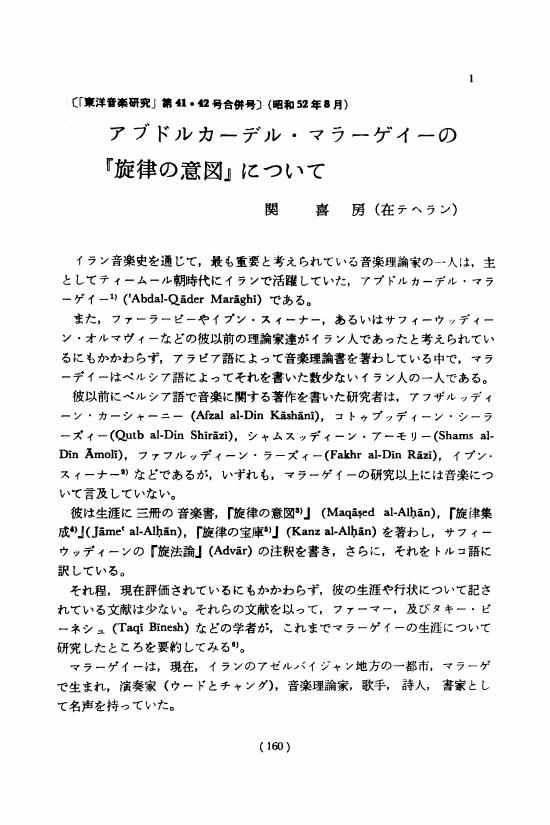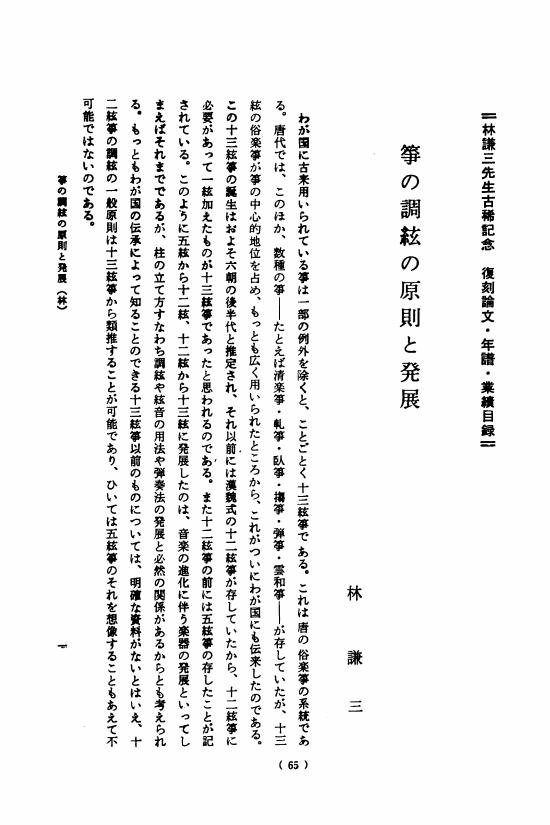10 0 0 0 OA 享保年代の新樂器「〓」について
- 著者
- 林 謙三
- 出版者
- 社団法人 東洋音楽学会
- 雑誌
- 東洋音楽研究 (ISSN:00393851)
- 巻号頁・発行日
- vol.1936, no.1, pp.57-63, 1936 (Released:2010-11-30)
5 0 0 0 OA 南山進流聲明概説
- 著者
- 中川 善教
- 出版者
- 社団法人 東洋音楽学会
- 雑誌
- 東洋音楽研究 (ISSN:00393851)
- 巻号頁・発行日
- vol.1954, no.12-13, pp.101-140, 1954-10-30 (Released:2010-11-30)
5 0 0 0 OA アブドルカーデル・マラーゲイーの『旋律の意図』について
- 著者
- 関 喜房
- 出版者
- 社団法人 東洋音楽学会
- 雑誌
- 東洋音楽研究 (ISSN:00393851)
- 巻号頁・発行日
- vol.1977, no.41-42, pp.160-150, 1977-08-31 (Released:2010-11-30)
2 0 0 0 OA 種子島の民謡
- 著者
- 松原 武実
- 出版者
- 社団法人 東洋音楽学会
- 雑誌
- 東洋音楽研究 (ISSN:00393851)
- 巻号頁・発行日
- vol.1976, no.39-40, pp.1-22, 1976-10-23 (Released:2010-11-30)
2 0 0 0 OA 箏の調絃の原則と発展
- 著者
- 林 謙三
- 出版者
- 社団法人 東洋音楽学会
- 雑誌
- 東洋音楽研究 (ISSN:00393851)
- 巻号頁・発行日
- vol.1968, no.24-25, pp.1-35, 1968 (Released:2010-11-30)
2 0 0 0 OA 琴楽の歴史的変遷
- 著者
- 三谷 陽子
- 出版者
- 社団法人 東洋音楽学会
- 雑誌
- 東洋音楽研究 (ISSN:00393851)
- 巻号頁・発行日
- vol.1976, no.38, pp.100-63, 1976 (Released:2010-11-30)
2 0 0 0 OA 眞言声明小談
- 著者
- 岩原 諦信
- 出版者
- 社団法人 東洋音楽学会
- 雑誌
- 東洋音楽研究 (ISSN:00393851)
- 巻号頁・発行日
- vol.1954, no.12-13, pp.161-172, 1954-10-30 (Released:2010-11-30)
2 0 0 0 蒙古の唄
- 著者
- 武田 忠一郎
- 出版者
- 社団法人 東洋音楽学会
- 雑誌
- 東洋音楽研究 (ISSN:00393851)
- 巻号頁・発行日
- vol.1951, no.9, pp.147-154, 1951
之は主としてモンゴンワチル君 (ジュルメンチョゴラン、ホーチンスルクホジュゴ出身― 蒙和敖齋爾、哲里木盟陳蘇魯克旗出身) 及ウルヂボイン君 (察吟爾盟出身) につき聽取したる蒙古の古い民謠 (現在もよく謠はれてゐるもの) を蒐集したものである。私は多年我國各地方の民謠及舞曲を採譜し之を研究して居るが、その比較研究の必要に迫ちれて蒙古の唄も聽いてみたところ、やはり日本古謠の或種のものと非常に似通つてゐる點の多いことを發見して驚いた。そして日本の子供等は何の不思議も無く之れ等蒙古の唄を受け入れたのである。私はその曲節の清純さと明朗さとに接して、健全そのものであるといふ感じに打たれ、かくの如き唄を持つ蒙古の人達に對し更に一層親愛の念を深めて來たのである。尤もこれ等蒙古の唄は詩の内容なり詩型なり、又た曲型に於て面白い特質があつて、研究に價すべき種々の材料を私に提供して呉れた。
2 0 0 0 遠藤徹構成『別冊太陽雅楽』
- 著者
- 寺内 直子
- 出版者
- 社団法人 東洋音楽学会
- 雑誌
- 東洋音楽研究 (ISSN:00393851)
- 巻号頁・発行日
- vol.2005, no.70, pp.146-149, 2005
2 0 0 0 箜篌の淵源
- 著者
- 岸辺 成雄
- 出版者
- 社団法人 東洋音楽学会
- 雑誌
- 東洋音楽研究 (ISSN:00393851)
- 巻号頁・発行日
- vol.1958, no.14, pp.231-232, 1958
1 0 0 0 OA 日本樂律論
- 著者
- 田邊 尚雄
- 出版者
- 社団法人 東洋音楽学会
- 雑誌
- 東洋音楽研究 (ISSN:00393851)
- 巻号頁・発行日
- vol.1936, no.1, pp.3-25, 1936 (Released:2010-11-30)
本稿は私が嘗て都山流尺八師匠の研究資科の爲めに、金澤市の大師範藤井隆山氏が編輯發行せる『都山流尺八教授資料』の第四號乃至第八號に流載したものを墓とし、之を補訂、抜萃して纒めたものである。
1 0 0 0 OA 中国古代音楽思想研究 第一集
- 著者
- 水原 渭江
- 出版者
- 社団法人 東洋音楽学会
- 雑誌
- 東洋音楽研究 (ISSN:00393851)
- 巻号頁・発行日
- vol.1965, no.18, pp.207-231, 1965-08-20 (Released:2010-11-30)
殷〓の発堀とそのト辞の放釈が試みられて以来、殷人の物質文化、あるいは、精神文化の一端が窺知されるに至うたが、要するに、段の王朝とは、黒陶を作り、農耕を生業とした一民族であって、盤庚に引率されて、山東の基部の曲阜より河南の安陽に移住し、彩陶の夏民族を征服して建てた所の王朝であるといえる。その殷の王朝の頃に、どのような形式内容の音楽が存在していたかについて、卜辞とか金文資料並びに後時史料等によって、多少の考察を加えたのが、中国古代音楽思想研究の第一集である。
1 0 0 0 日本歌謡研究資料集成
- 著者
- 竹内 道敬
- 出版者
- 社団法人 東洋音楽学会
- 雑誌
- 東洋音楽研究 (ISSN:00393851)
- 巻号頁・発行日
- vol.1984, no.49, pp.139-142,L7, 1984
Historical source material of good quality, valuable as it as an endless source of stimulation for researchers, is almost invariably high in price and difficult to obtain. For that reason, we must turn most often to the facilities offered by libraries, but in the case of important primary material, the rarer it is the more likely it is to be available for use only under strict regulations, and it is often impossible for younger researchers to actually touch and inspect at close range. In many cases, there is often no alternative to using typographical reprints of certain sources, an alternative that of course involves a number of other difficult problems. It is most important, however, that basic primary sources should be viewed in their original forms whenever possible.<br>Accordingly, the publication of this ten-volume series of basic source material in photographic reproduction, which makes possible an appreciation of the sources in the closest form to the actual object itself, should be highly welcomed. The contents of each volume in the series are as follows:<br>(Translator's note: It should be noted that there are certain problems associated with reading the names of these sources, some of which will be outlined below, and that not all possibilities have been included here; in most cases, the generally-accepted reading of the name in modern Japanese has been adopted.)<br>In all a total of 39 items are reproduced in full photographic facsimile, with commentary on the sources included at the end of each volume. The collection of such an amount of material was obviously quite a difficult task, and gratitude should be expressed towards those involved with publication, as well as the four supervisors of the series, Asano Kenji, Shida Nobuyoshi, Hirano Kenji and Yokoyama Shigeru.<br>A quick glance at the contents of the volumes reveals firstly that these source materials are all from the Edo period (<i>Kinsei</i>), and that the collection is therefore a collection of vocal sources of the Edo period. The first problem with the collection is, then, that its name is too wide, since there are of course a large number of source materials for vocal genres from earlier periods. A table of contents of the series given at the back of each volume (except for some reason Vols. 7, 9 and 10) includes the information that this is a collection of Edo-period sources, although this is not stated on the cover-box or spine of each volume.<br>There is a problem too with the range of material included in the publication. It would seem clear from earlier research in the field and from the title of the publication that more source material dealing with <i>shamisen</i> music should be included. It would be helpful if there was some sort of explanation for the reasons behind the choice of the 39 items, but unfortunately no such text can be found. Without such an explanation it is hard to evaluate the choice of materials and the editorial policy behind the publication. It would be helpful to have this included if there is any possibility for publication of a second edition.<br>Below is a short listing in no special order of a number of other problems associated with the publication, although it should be noted that these do not effect the value of the series as a whole; indeed they are likely to be problems that the supervisors and other contributors to the series have already noticed.
- 著者
- 塚原 康子
- 出版者
- 社団法人 東洋音楽学会
- 雑誌
- 東洋音楽研究 (ISSN:00393851)
- 巻号頁・発行日
- vol.1988, no.52, pp.43-77,L6, 1987
This article provides a detailed introduction to the musical materials of Udagawa Yoan (1798-1846) and undertakes an examination of them from the perspective of the introduction and reception of foreign culture. Although Yoan is well known as a scholar of European studies involved in the introduction of chemistry and botany from the West, little work has been done on his written works dealing with music. In this article, an examination of his draft translations that deal with European music, and their Dutch-language originals, has been undertaken, and comparison has also been made to his works that deal with the music of the Chinese Qing (Ch'ing) dynasty. Two of his draft translations of special importance, one entitled <i>Oranda hoyaku</i>: <i>Yogaku nyumon</i> (‘Translation into Japanese from the Dutch: Introduction to European music’) and one comprising sections dealing with music in <i>Oranda shiryaku</i> (‘Record of Dutch matters’), have been reprinted typographically and appended to the article as reference material (see pp 59-71 and 71-77 of the Japanese text).<br>The major results of this examination can be summarized as follows:<br>1. In addition to those of Yoan's autograph manuscripts dealing with music that have been mentioned in earlier research, namely <i>Shingaku-ko</i> (‘Examination of the music of the Qing [Ch'ing] dynasty’), <i>Oranda hoyaku</i>: <i>Yogaku nyumon</i> (see above), <i>Taisei gakuritsu-ko</i> (‘Examination of the musical pitches of the Great West’), <i>Gakuritsu kenkyu shiryo</i> (‘Materials for research on musical pitches’), and <i>Teito hiko tozai gakuritsu</i> (‘Secret manuscript on the musical pitches of East and West’), it was ascertained that major accounts dealing with European music can also be found in parts of <i>Oranda shiryaku</i> (see above). In addition, Yoan copied parts of the 16th-century <i>gagaku</i> compendium <i>Taigen-sho</i>, and possessed for reference purposes <i>Onritsu-ron</i> (‘Treatise on musical pitch’) of the Japanese Edo-period Confucian scholar Kondo Seigai. All of Yoan's manuscripts dealing with music are first drafts, and it is clear that he was not a specialist in musical matters. The materials are valuable, however, since there are no other materials from the late Edo period of this scope that are indicative in concrete terms of the various aspects of the contemporary reception of foreign music, especially that of Europe.<br>2. The musical materials of Yoan dealt with in this article can be broadly divided into three groups: manuscripts dealing with music of Qing (Ch'ing) dynasty China; draft translations dealing with European music; and Japanese materials on musical pitch either copied or used as reference sources.<br>3. Comparison of the two groups of materials dealing with non-Japanese music has shown that those dealing with the music of China are more practical, reflecting Yoan's contact with actual musical activity, since they include traced diagrams of instruments and a collection of texts with musical notation (a manuscript copy of <i>Seishin gakui</i> compiled by Egawa Ren). In contrast to this, his draft translations dealing with European music center on explanations of instruments and pitch theory, matters that can be argued without reference to actual musical practice.<br>4. In rendering technical terms used for European music, Yoan limited himself basically to transliteration of the sounds of the words in Japanese, although at the same time contrasting them with the notational signs of Qing (Ch'ing) music and the pitch-names used in <i>gagaku</i>, and making reference to the text <i>Onritsu-ron</i> mentioned above. Although isolated in nature because they deal with Western music, Yoan's draft translations can be viewed as a continuation of the tradition of research on musical pitch as undertaken by the Confucian scholars of Japan's Edo period.<br>5. The
1 0 0 0 琉球における中国戯曲の受容
- 著者
- 劉 富琳
- 出版者
- 社団法人 東洋音楽学会
- 雑誌
- 東洋音楽研究 (ISSN:00393851)
- 巻号頁・発行日
- vol.2007, no.72, pp.83-95, 2007
琉球は、一三七二年に中国と冊封朝貢関係を打ち立て、一六三四年に江戸上りが始まり、中国や日本からの文化を受けながら、さまざまな芸能を育んできた。<br>琉球組踊は、科白や音楽や舞踊などからなる琉球の伝統的歌舞劇である。組踊と日本芸能との比較についてはこれまで日本側の多くの研究者が言及し、組踊が能をはじめ日本芸能からの影響を受けたとみているが、これらの研究は中国戯曲との関連に触れていない。組踊と中国戯曲との繋がりは少数の研究者が言及しているが、琉球において中国戯曲はどのような状況にあったかについては、まだ研究が進んでいない。<br>本研究は、琉球に伝わった中国戯曲について記述した史料をめぐって、史料の面から琉球における中国戯曲の様相を明らかにしたいと思う。<br>本研究で使用する史料は主に使琉球録や江戸上り史料である。使琉球録は中国の冊封使が冊封活動の経過を書いた文書である。江戸上り史料は琉球江戸上りの経過を書いた記録である。<br>使琉球録については郭汝霖『使琉球録』(一五六一)、謝傑『琉球録撮要補遺』(一五七九)、夏子陽『使琉球録』(一六〇六)、胡靖『杜天策冊封琉球真記奇観』(一六三三) 及び袋中上人『琉球往来』(一六〇五) などの史料を調べ、一六世紀後半~一七世紀初頭、中国戯曲は琉球に伝わってきて上演されたことが分かった。<br>江戸上り史料について調べた結果、琉球の江戸上りの際に、琉球人が中国音楽 (戯曲) を演じたことが分かった。<br>以上の史料から見て、琉球における中国戯曲の受容は組踊に影響を与えただろうと考えている。
1 0 0 0 箏組歌本と砧物
- 著者
- 平野 健次 久保田 敏子
- 出版者
- 社団法人 東洋音楽学会
- 雑誌
- 東洋音楽研究 (ISSN:00393851)
- 巻号頁・発行日
- vol.1970, no.30, pp.41-83, 1970
1 0 0 0 OA 催馬楽の音階と旋法 和洋音楽の音階と旋法・各論のうち
- 著者
- 篠田 健三
- 出版者
- 社団法人 東洋音楽学会
- 雑誌
- 東洋音楽研究 (ISSN:00393851)
- 巻号頁・発行日
- vol.1965, no.18, pp.176-206, 1965-08-20 (Released:2010-11-30)
芝祐泰採譜「雅楽第二集催馬楽総譜」 (龍吟社、一九五六年) を用いて以下、催馬楽の旋法を考える。まず歌謡旋律の部分のみを対象として分析したい。
1 0 0 0 民族楽器の大量生産
- 著者
- 柚木 かおり
- 出版者
- 社団法人 東洋音楽学会
- 雑誌
- 東洋音楽研究 (ISSN:00393851)
- 巻号頁・発行日
- vol.2006, no.71, pp.65-83, 2006
バラライカは三角形の胴に三本の弦をはった有棹撥弦楽器で、ロシアの民族楽器として広く知られている。この楽器には、音楽事典などに見られるような、板を張り合わせて作った粗末な自作楽器あるいは職人が製作した楽器であるというイメージが先行しがちだが、数量から言えば、工場で大量生産されたものが圧倒的に多い。本稿は、民族楽器の大量生産が文化政策の一環として行われた経緯と理念を一九二〇~三〇年代の五ヵ年計画との関連において分析し、楽器大量生産の後世への影響を考察するものである。<br>ソ連は、「資本主義諸国に追いつき、追い越せ」をスローガンに様々な政策を打ち出した。五ヵ年計画はもともと工業部門の発展を目的とした国家規模の計画であるが、そのうち第二次五ヵ年計画 (一九三三~三八) には特に芸術部門の組織化が含まれた。その計画書の冒頭には「安価で良質な楽器の普及が、社会の文化水準の高さを示す」と述べられており、実にその理念にしたがって民族楽器の国を挙げての大量生産が行われるようになった。<br>世界初の社会主義国ソ連では、文化は国によって計画、運営、管理されるものであり、その意味で「国営文化」だった。工場製の楽器の生産と流通によって、より多くの人々が楽器を手にすることができるようになり、その楽器とともに、政策施行者側が推奨した「文化的な」音楽文化も組織的に普及することになった。しかし楽器の普及は、他方で、「非文化的である」として当局が排除しようとした農民の伝統的な器楽曲や世俗的なレパートリーを根絶するばかりか、政策被施行者側の工夫により、逆に生き残らせるという結果をもたらした。それらは、政策施行者側の推進した工場製楽器によって現在も鳴り響いている。
1 0 0 0 一九二〇~三〇年代における大和流ご詠歌の成立過程
- 著者
- 新堀 歓乃
- 出版者
- 社団法人 東洋音楽学会
- 雑誌
- 東洋音楽研究 (ISSN:00393851)
- 巻号頁・発行日
- vol.2008, no.73, pp.63-75, 2008
ご詠歌は日本に伝わる宗教音楽のひとつであり、主に在家の仏教信者が四国遍路などの巡礼や葬式などの儀礼でご詠歌をうたうほか、稽古事としてもこれを伝習している。本稿は、現在に伝わるご詠歌諸流派の基礎を形作った大和流を対象に、その成立過程を明らかにする. 大和流は一九二一年、山崎千久松によって創始された。千久松はご詠歌の基本となる節を十一に整理し、ご詠歌の普及と仏教信者の教化を図って大和流の伝承団体「大和講」を設立した。大和講はその長である講主と、講主の下でご詠歌を伝承する多くの講員から成るが、千久松は自らが講主となってご詠歌の指導に当たり講員を増やしていった。<br>こうして大和講が成立すると、ご詠歌の伝承が大きく変容した。第一に、大和講はご詠歌の歌詞と節を記した歌集を全国発売して伝承の統一を図った。第二に、ご詠歌の歌い手が検定試験に合格すると階級が取得できるという制度を置いて、日本の諸芸能に見られるような家元制度と同様の伝承組織を形成した。第三に、詠唱技術を競う全国規模のコンクールを開催するようになった。こうして大和講は、中央の本部が全国各地の支部を統括するという一大組織を築くことができた。<br>大和講が全国に広く普及することができた要因として最も重要と思われるのが、家元制度と同様の伝承組織を形成したことである。大和講では、一定の階級を取得した者が講主に代わってご詠歌を指導するため、講主自身が直接伝授に当たることなく多くの弟子を抱えることができる。これは家元制度に特徴的なもので、大和講ではこうした制度を備えたために伝承者を増やして一大組織を築くことができたと考えられる。
1 0 0 0 OA 琴歌譜の音楽的解釈の試み
- 著者
- 林 謙三
- 出版者
- 社団法人 東洋音楽学会
- 雑誌
- 東洋音楽研究 (ISSN:00393851)
- 巻号頁・発行日
- vol.1965, no.18, pp.67-102,en4, 1965-08-20 (Released:2010-11-30)







